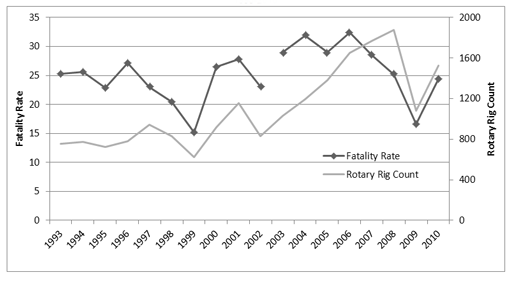OIL AND GAS EXTRACTION

Inputs: Occupational Safety and Health Risks
Fatalities
The oil and gas extraction industry has an annual occupational fatality rate of 27.5 per 100,000 workers (2003-2009) - more than seven times higher than the rate for all U.S. workers. The oil and gas extraction industry employed approximately 435,000 workers in 2010. The annual occupational fatality rate in this industry is highly variable; this variation is correlated with the level of drilling activity in the industry (Figure 2). Fatality rates are higher when there is an increased number of active drilling and workover rigs. This could be a result of an increase in the proportion of inexperienced workers, longer working hours (more overtime), and the utilization of all available rigs (older equipment with fewer safeguards).
Although fatal injuries to these workers were identified as a pressing issue more than a decade ago, recent data show that the problem continues. For example, during 2003 to 2009 ( Census of Fatal Occupational Injuries ) 716 oil and gas extraction workers were killed on-the-job, resulting in an annual fatality rate of 27.5 deaths per 100,000 workers (compared to 3.9 for all U.S. workers). Of the 716 fatalities that occurred during 2003-2009, the majority were either highway motor vehicle crashes (29%) or workers being struck by tools or equipment (20%). The next most common fatal events were explosions (8%), workers caught or compressed in moving machinery or tools (7%), and falls to lower levels (6%).
Figure 2: Annual Occupational Fatality Rate among Oil and Gas Workers and Number of Active Rotary Rigs, 1993-2010

Note: The break in the fatality rate line indicates the industry definition change which occurred in 2003.
Sources: Fatalities – Bureau of Labor Statistics, Census of Fatal Occupational Injuries (1993-2002 Standard Industry Classification 13; 2003-2006 North American Industrial Classification System 211, 213111, 213112); Employment – Bureau of Labor Statistics (1993-2002 Current Population Survey ; 2003-2010 Quarterly Census of Employment and Wages ), Rig Count – Baker Hughes Inc. (1993-2010 Sum of annual average for Active Rotary Rigs for the United States).
Nonfatal Injuries
Most segments of oil and gas extraction report a lower nonfatal injury rate than the average for all private industry. In 2010 the estimated rate of nonfatal work-related injuries in oil and gas extraction (NAICS 211) was 1.2 per 100 full-time workers, 1.9 for workers in support activities for oil and gas extraction (NAICS 213112), and 3.3 for drilling oil and gas wells (NAICS 213111). The annual rate for all private industries during the same year was 3.5 nonfatal injuries per 100 full-time workers.
Health Risks
There currently exists little published information identifying or characterizing potential health risks to U.S. oil and gas extraction workers. This is an area that needs further research, particularly in material inventory, exposure characterization, and surveillance.However, based on recent field studies by NIOSH, worker exposure to respirable crystalline silica has been identified as a potential hazard during hydraulic fracturing operations ( OSHA NIOSH Hazard Alert: Worker Exposure to Silica During Hydraulic Fracturing [PDF - 2 MB] ). Other suspected health hazards, that have not yet been quantified, may include exposure to diesel particulate and exhaust gases from equipment, high or low temperature extremes, noise, hydrocarbons, hydrogen sulfide, heavy metal exposure, and naturally occurring radioactive material (NORM).
Sources
Census of Fatal Occupational Injuries , BLS, Department of Labor
Current Population Survey , BLS, Department of Labor
Quarterly Census of Employment and Wages , BLS, Department of Labor
Baker-Hughes North American Rig Count
Injury, Illness and Fatality Program , BLS, Department of Labor
Disclaimer: Mention of any company name or product does not constitute endorsement by the National Institute for Occupational Safety and Health for the content of these Web sites.
Previous Page: Economic Factors Next Page:National Research Agenda (NORA)
- Page last reviewed: December 13, 2012
- Page last updated: December 13, 2012
- Content source:
- National Institute for Occupational Safety and Health Western States Office


 ShareCompartir
ShareCompartir